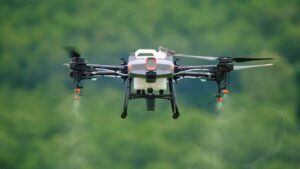 As the Drone Nerds’ ElevateUAV Summit kicked off in Miami this morning, the Keynote speech highlighted fastest growing verticals in the commercial drone industry. Among these is agriculture: a leading vertical since the industry launched. Since 2016 and the implementation of Part 107, precision agriculture in the U.S. has improved and grown steadily. New sensors, new software, and easier to fly drones have all contributed to the widespread use of drones to analyze crop health and maximize yields.
As the Drone Nerds’ ElevateUAV Summit kicked off in Miami this morning, the Keynote speech highlighted fastest growing verticals in the commercial drone industry. Among these is agriculture: a leading vertical since the industry launched. Since 2016 and the implementation of Part 107, precision agriculture in the U.S. has improved and grown steadily. New sensors, new software, and easier to fly drones have all contributed to the widespread use of drones to analyze crop health and maximize yields.

Crop spraying is a specific use for agricultural drones – one that offers a powerful ROI for operators. A service provider with the Part 137 Operating Certificate can recoup their equipment investment in a single growing season – while still offering farmers a cost benefit over spraying from the ground. Drone attorney Jonathan Rupprecht presented a session on Part 137 to a packed room of service providers, all interested in the process of getting certified to utilize spraying drones. (Rupprecht notes that operators must also comply with state chemical spraying regulations.)
Benefits of Spraying Drones
Spraying drones offer significant value for both growers and service providers. Using drones, spray can be applied more precisely, reducing costs and chemical wastes. Spraying drone reduce the risk of chemical exposure for service providers. Spray can be applied to inaccessible or wet areas, without damaging the ground. Chemicals can be applied at night, to limit exposure to beneficial insects like bees. Finally, Rupprecht comments, there are a small number of FAA certificated spray operators out there – which means those who have gone through the process have a business opportunity.
Part 137: Agricultural Operations
U.S. service providers who want to operate spraying drones must comply with Code of Federal Regulations (CFR) Part 137: Agricultural Aircraft Regulations. This doesn’t apply to precision agriculture operations, where drone operators collect data for comparison with plant health charts or perform other analysis. Part 137 applies directly to spraying operations:
Agricultural aircraft operation means the operation of an aircraft for the purpose of
(1) dispensing any economic poison,
(2) dispensing any other substance intended for plant nourishment, soil treatment, propagation of plant life, or pest control, or
(3) engaging in dispensing activities directly affecting agriculture, horticulture, or forest preservation, but not including the dispensing of live insects.
While operators are categorized under recreational, government, or civil – most operators fall under the civil category. Government operators must not be receiving any compensation for the operation, which eliminates most service providers from this category. Even farmers flying on their own property must get a Part 137 certification.
The process of receiving the Part 137 certificate is complex, and requires thought about the benefits of using aircraft that weighs more than 55 pounds balanced against the additional complications of compliance vs. using an aircraft weighing less than 55 pounds.
The Potential for Drone Operators
Engaging in the exemption process can make spraying drones more profitable for services providers. Rupprecht has received 5 swarm approvals to date, which allow a single pilot to operate multiple drones. BVLOS approvals and night operations also present opportunities during the growing season – and much agricultural land is in low risk airspace.
Like any business, agricultural spraying depends upon where you are. “[Spraying drones provide] an opportunity to serve clients who can’t access manned aircraft services,” says Rupprecht. “Depending upon the customer, the location, and market conditions spraying can be a profitable area for service providers.”
Find more information on the pitfalls, potential and process on drone attorney Jonathan Rupprecht’s website here.

Miriam McNabb is the Editor-in-Chief of DRONELIFE and CEO of JobForDrones, a professional drone services marketplace, and a fascinated observer of the emerging drone industry and the regulatory environment for drones. Miriam has penned over 3,000 articles focused on the commercial drone space and is an international speaker and recognized figure in the industry. Miriam has a degree from the University of Chicago and over 20 years of experience in high tech sales and marketing for new technologies.
For drone industry consulting or writing, Email Miriam.
TWITTER:@spaldingbarker
Subscribe to DroneLife here.







[…] Source link […]